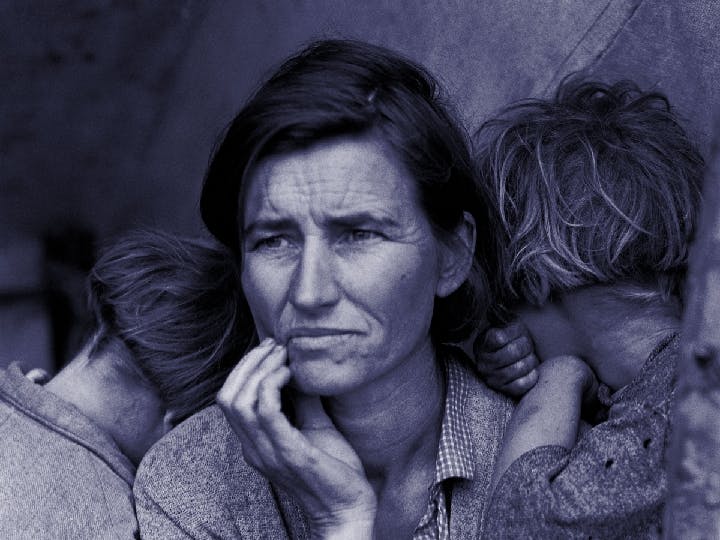The Inequality of Single Motherhood
– Maya Wesby
In America, the rise of single motherhood is entangled with growing income inequality. What are the trends behind this rise, and what, if anything, can break the cycle of poverty?
Jessica Schairer is a portrait of a new reality for many modern, working-class Americans. She lacks a college degree and earns a trivial paycheck; she has three children, but she is alone.
Single motherhood was not Schairer’s intention. When she got pregnant during her first year of college, her initial thoughts were of abortion. Her boyfriend at the time thought it would be best to start a family, but with little income, persistent emotional abuse, and no home of their own, a breakup was inevitable. Jessica Schairer now has a job as the assistant director of a child care center, where she earns an annual income just under $25,000. It’s enough, she told the New York Times, to pay for rent, food (with the aide of food stamps), and clothing for herself and her children. But it is not enough.
Despite living in poverty, Schairer remembers the lifestyle she grew up with, one that revolved around church, school, and traditional marriages. “I thought, ‘I’ll meet someone, and we’ll marry and have kids and the house and the white picket fence,’” she said. “That’s what I wanted. That’s what I still want.”
Jessica Schairer’s experience as a single parent is a common one. For those in her demographic — that is, white women with some postsecondary schooling but who lack a college degree — becoming a single mother is the norm. The rise of single motherhood for this demographic speaks for itself — in 1990, 11 percent of births occurred outside of marriage; in 2009, that number rose to 34 percent.
The poverty-stricken nature of single motherhood is true of women across the demographic spectrum. The number of single-parent families has tripled nationally since 1960, and 80 percent of these families are headed by women. The percentage at or below the poverty line rose from 33 percent in 2000 to 41 percent in 2011.
Research from Bruce Western and Tracey Shollenberger of the Harvard sociology department found that while the percentage of two-parent households declined across all economic strata between 1968-2010, the decline was most prevalent among members of the two lowest income quartiles.
Part of why these groups have experienced such a precipitous decline is due to the surprising economics of marriage. A 2010 report by the Pew Research Center found that between 1979 and 2007, incomes fell for men who lacked college degrees. At the same time, women at every level of educational attainment except for high school dropouts saw an increase in income. This resulted in more men at the top and bottom of the income ladder, with a larger group of women in the middle with fewer economically compatible partners.
The problem, as explained in Daniel Patrick Moynihan’s 1965 memo on “The Tangle of Pathology,” is that the decline of stable employment for men in a social group results in unstable marriages and family life, and also encourages men to exhibit bad behavior. For women in these poorer communities, there’s an understandable desire not to choose a long-term partner and active father figure for their children from this pool of men with job instability, chronic unemployment, violent behavior, histories of incarceration, and substance abuse problems. As a divorced, low-income mother told Politico in 2014, “I can take care of myself. I can take care of myself and the kid. I just can’t take care of myself, the kid, and him.”
Unsurprisingly, living in poverty affects the children of families as well as the parents. However, income inequality drives a wedge between the successes of children with married versus unmarried parents. Children in two-income, two-parent households are more likely to rise out of lower classes than children with single parents. The particular absence of a father, note Princeton’s Sara McLanahan and Harvard’s Christine Percheski, “is associated with a host of negative outcomes that are expected to affect children’s future life chances or ability to move up the income ladder,” and results in lower educational achievement, substance abuse, depression, and teen pregnancy. Because lower-class children with a single mother aren’t likely to progress away from their circumstances, the cycle of poverty continues.
What can be done to lessen the inequality that exists between single mothers and other families? Polls in the Center for American Progress’s 2014 Shriver Report suggest that most Americans believe that policies should be adjusted to help low-income single-parent households, rather than trying to implement regulations that invade the lives of single parents. Despite partisan divides, a majority of Democrats and Republicans support a variety of measures that would economically assist single parents, including scholarships, the promotion of minimum wage, and paid leave.
Despite the optimistic view that the public seems to have towards helping single mothers, economic inequality is still a reality for many like Jessica Schairer. She doesn’t regret the life circumstances surrounding her; “I’m in this position because of decisions I made,” she said. But until policies can be improved such that single-parent families can thrive like their married counterparts, those like Schairer are faced with chaotic days, lonely nights, and a struggle to get by.
The Sources:
Jason DeParle, “Two Classes in America, Divided by ‘I Do’,” The New York Times, July 14, 2012.
June Carbone and Naomi Cahn, “The New Math of the Single Mother: Why the ranks of America’s unmarried moms keep growing,” Politico Magazine, October 13, 2014.
Olga Khazan, “The Plight of Single Moms – and the Policies That Would Help,” The Atlantic, January 14, 2014.
Jason DeParle, “Economic Inequality and the Changing Family,” The New York Times, July 14, 2012.
Photo courtesy of the Library of Congress
